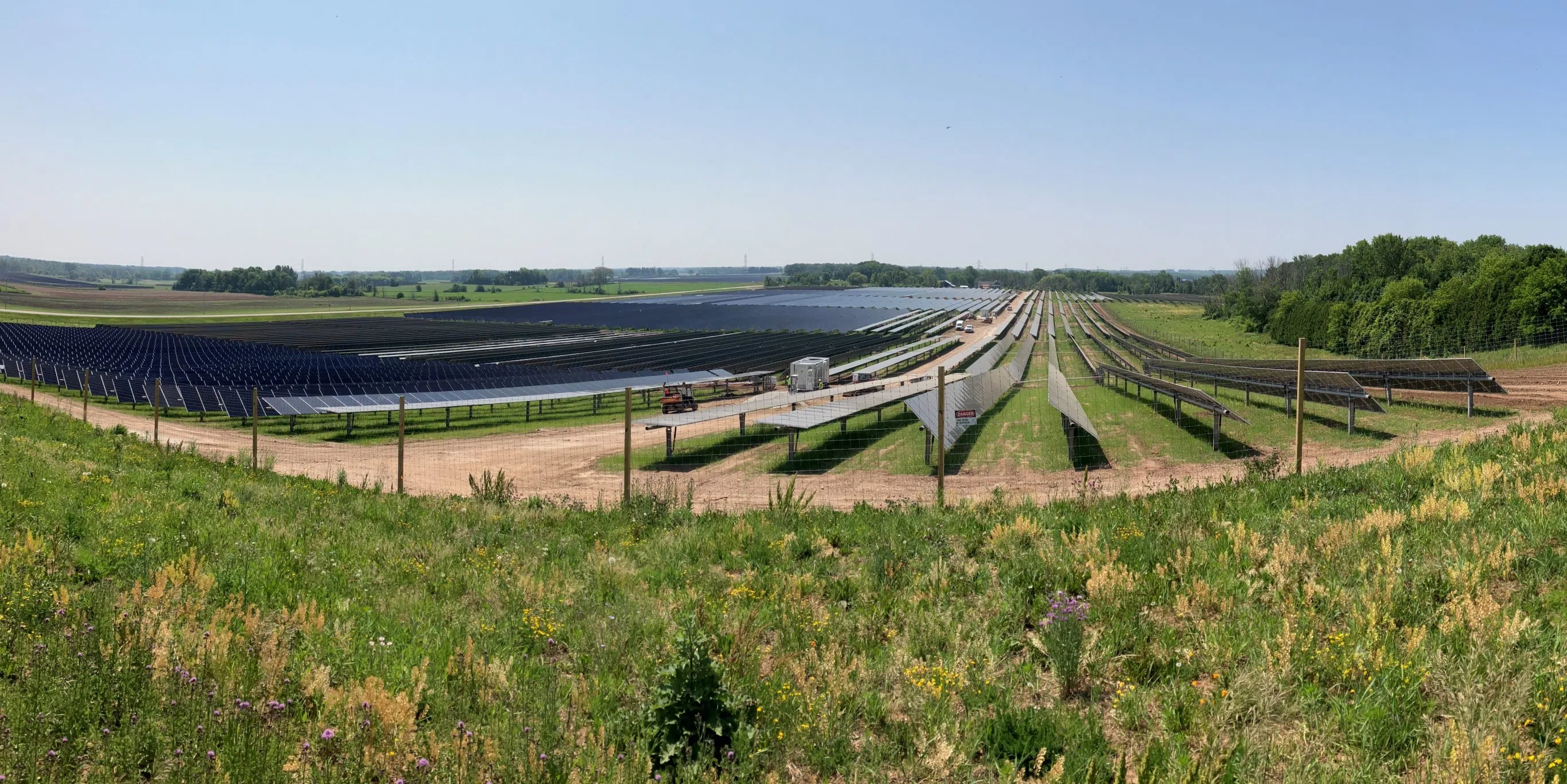The gently rolling hills of southern Sheboygan County have hosted fields of one sort or another for the better part of the past 200 years. Traditionally, those fields have grown corn and other crops that were harvested and then fed to either humans or cattle in this heart of the dairyland. But now, another sort of harvest is to be taken, not from the soil, but from the sun that falls on those same fields. And although the color “green” is often used to label this harvest, the color of the panels that gather light and turn out electricity is dark blue, assembled in row upon row across some 1,000 acres comprising the Onion River Solar Project.
The project was first announced by the Town of Holland and Sheboygan County on November 10th of 2020 after an agreement was finalized with no dissenting votes by both the Town of Holland Town Board and the County Board of Sheboygan County. Under that agreement, the Town and County anticipate receiving annual shared revenue payments of $250,000 and $350,000 respectively, while annual payments will be made to the Cedar Grove and Oostburg School Districts and Lakeshore Technical College to compensate for tax revenues that would have come to each from property in the project. After receiving approval from the Public Service Commission of Wisconsin in 2021, construction began earlier this year with preparation of the fields, and then the installation of the posts that support the racks, which then host the photovoltaic – or solar – panels along with the equipment that keeps them pointed at the sun in order to maximize the amount of energy gathered. One by one the fields were ready to receive the panels themselves, installed now at a rate of about 4,000 per day. As of the beginning of July, the installation is 66% done and, by the end of this year, should be producing enough electricity from its 387,000 panels to power some 40,000 homes.

Fields Prepared With Posts that will Support Racks of Solar Panels. Photo by Kevin Zimmermann

Solar Panels Installed on Racks. Photo by Kevin Zimmermann

Inverters Like This One Convert the Direct Current from Solar Panels Into Alternating Current That’s Delivered on the Grid. Photo by Kevin Zimmermann
During an interview in late June, Project Manager Randy Bermke, Construction Manager Jared Stensby, and Communications Partner Chris Caporale of Alliant Energy which owns the project, answered questions during a tour of the partially-completed facility. One of the first questions concerned how practical solar energy is at our latitude – nearly halfway between the equator and the north pole – a location where the sun spends a considerable amount of the year at a low angle and often shrouded in clouds for days at a time between late fall and springtime. Randy Bermke said that during its formative years it was assumed that solar energy would be challenging this far north, but as the technology has progressed, generating solar power here has become viable. That progress takes place quickly enough that the first concept plans for Onion River involved more acreage than the present 1,000 acre footprint. Better technology that’s been developed since 2020 allowed the project developer, Ranger Power of Brooklyn, New York, to scale down the area required. Alliant Energy acquired the Onion River Solar Project from Ranger Power once the permitting process was complete, and has overseen its construction ever since. Chris Caporale added that even with seasonal and daily variations, those variations are largely predictable, and careful resource-planning helps coordinate with other means of generation.
Those “other means” refer to covering generating gaps caused by clouds, reduced daylight hours during the cold months, and the obvious problem with solar in that no electricity is generated at night. For now, Alliant will depend primarily on natural gas generation to fill the gap, while wind and hydroelectric generating facilities make up the rest of the mix. Coal, as is used at Sheboygan’s Edgewater Unit 5, is scheduled to be eliminated entirely by Alliant Energy by 2040.Another element towards a more dependable, carbon-free energy economy is the development of battery storage facilities. Such an operation is being planned on the grounds of the soon-to-be decommissioned Edgewater Generating Facility. The 99 Megawatt Edgewater Battery Project will involve around 7 acres of land using lithium iron phosphate battery cells, which are completely sealed and don’t contain any toxic heavy metals, are resistant to degradation, easier to recycle and have a longer life cycle than other metal oxide lithium-ion cells. With those batteries, Edgewater will be able to store 396 megawatt-hours of energy generated when the wind blows and the sun shines…enough to power 100,000 homes when it’s dark or the winds are calm. Upon the eventual retirement of Edgewater Unit-5, 400 megawatts of coal generation will be taken offline. The Onion River solar project will replace 150 megawatts during the daytime. Construction Manager Jared Stensby added that other Alliant solar facilities will also be contributing to the grid, with a comparable 150MW solar plant in Two Rivers, a 100MW facility in Lomira, and one in Jefferson County projected to supply another 75MW.

(L-R) Onion River Solar Project Manager Randy Bermke, Construction Manager Jared Stensby and Alliant Communications Partner Chris Caporale at the Onion River Solar Project Construction HQ. Photo by Kevin Zimmermann
Looking at the Onion River Solar Project from ground-level…depending upon where you are…one may not be seeing a whole lot of it. Although the grounds are far from mature, the eventual growth of ground cover, vegetative buffers, pollinator-friendly plantings and treelines will enable the project to be a less visible, more compatible part of the countryside. Chris Caporale said that in general, the land has been left as close to original as possible. Temporary holding ponds helped control runoff during excavation, and while the heavy construction was underway the surrounding roads were continually swept and cleaned of dirt and debris to reduce what was tracked onto them from the fields. Once the solar plant is complete only periodic maintenance will be needed to remove the odd, tall-growing weeds that may find their way into the intentionally short-statured plantings that are being established. Already, according to Bermke, beekeepers in the area have reported increased honey production due to the pollinator-friendly growth being installed under and around the panels, and Caporale added that by fall the Onion River project will look much as it’s expected to appear for the next 30 years.
In 30 years, Alliant’s lease on the land will expire, the facility will be removed leaving only underground wires, and the land will be returned to the owners in nearly its original shape. The generating panels, which typically decline to about 85% of generating capacity after 25-30 years, will still be valuable and either sold, or donated to non-profits for continued generation. Until then, the Onion River Solar Project will be a key element in a greener energy future for the Town of Holland, Sheboygan County and Wisconsin.





